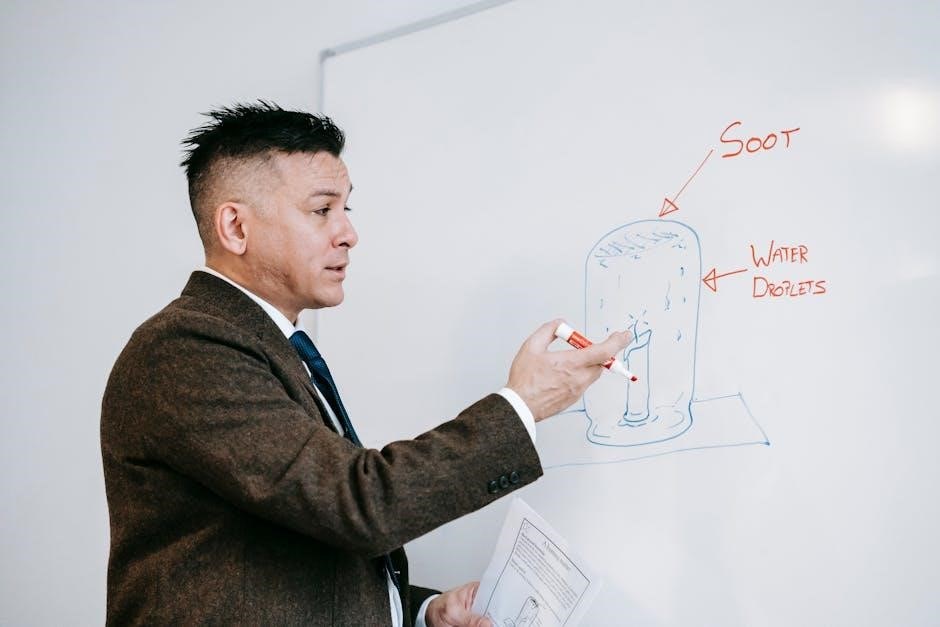First published in 2001, Classroom Instruction That Works by Robert J. Marzano, Debra J. Pickering, and Jane E. Pollock revolutionized teaching by linking evidence-based strategies to student achievement. This seminal work, grounded in meta-analysis, identifies nine high-yield instructional strategies proven to enhance learning outcomes, offering educators a practical framework for effective teaching across subjects and grade levels.
1.1 Overview of the Book and Its Importance
Classroom Instruction That Works is a groundbreaking educational resource that provides research-based strategies to enhance student learning. First published in 2001, it has become a cornerstone for educators, offering practical techniques backed by robust evidence. The book identifies nine high-yield instructional strategies, such as identifying similarities and differences, reinforcing effort, and setting objectives, which have been proven to significantly impact student achievement; Its importance lies in its ability to bridge the gap between educational research and classroom practice, making it accessible for teachers across various subjects and grade levels. With over a million copies sold, it remains a vital tool for improving teaching effectiveness and student outcomes.
1.2 Historical Context and Evolution of the Book
Classroom Instruction That Works emerged from Robert J. Marzano’s pioneering meta-analysis of educational research in 1998, which identified effective teaching strategies. First published in 2001, the book revolutionized education by linking classroom practices to measurable student outcomes. Its impact was immense, selling over one million copies and becoming a foundational text for educators globally. Over the years, the book has evolved, incorporating new research and refining its framework. The latest edition integrates modern evidence-based practices, ensuring its relevance in today’s educational landscape. This evolution underscores its enduring influence in shaping effective teaching methods and improving student achievement worldwide.
1.3 Key Authors and Contributors: Robert J. Marzano, Debra J. Pickering, and Jane E. Pollock
Robert J. Marzano, a renowned educational researcher, is the primary author of Classroom Instruction That Works. His work focuses on identifying and translating research into practical strategies for educators. Debra J. Pickering, an expert in curriculum design and instruction, contributed significantly to the book’s framework. Jane E. Pollock, known for her expertise in instructional strategies, played a crucial role in refining the nine high-yield strategies. Together, their collaboration brought a comprehensive understanding of effective teaching practices, making the book a cornerstone for educators seeking evidence-based methods to enhance student learning and achievement.

The Nine High-Yield Instructional Strategies
Marzano’s nine high-yield strategies are effective methods for improving student learning, including identifying similarities, reinforcing effort, setting objectives, and using cues and questions to enhance understanding.
2.1 Identifying Similarities and Differences
Identifying similarities and differences is a cornerstone strategy in Marzano’s framework, enhancing critical thinking and comprehension. Teachers use techniques like Venn diagrams and Venn diagrams to help students compare concepts, fostering deeper understanding and the ability to classify information effectively. This strategy is particularly powerful for engaging students in active learning and making abstract ideas more concrete. By highlighting connections between new and existing knowledge, educators can build a stronger foundation for student achievement across various subjects. This approach not only improves academic performance but also cultivates essential skills for lifelong learning and problem-solving.
2.2 Reinforcing Effort and Providing Recognition
Reinforcing effort and providing recognition are vital strategies that foster a positive classroom environment and motivate students to engage deeply with learning. By acknowledging students’ hard work and progress, teachers cultivate a sense of accomplishment and resilience. Marzano’s research emphasizes that genuine, specific, and timely feedback strengthens student confidence and perseverance. This strategy encourages students to view challenges as opportunities for growth, rather than obstacles. Through verbal praise, written notes, or public recognition, educators can create a supportive atmosphere where effort is valued as much as achievement. This approach not only enhances academic performance but also nurtures a growth mindset, empowering students to take ownership of their learning journey.
2.3 Setting Objectives and Providing Feedback
Setting clear learning objectives and providing constructive feedback are cornerstone strategies in Marzano’s framework. By establishing specific, measurable goals, teachers guide students toward understanding expectations and tracking progress. Feedback, when timely and specific, enables students to identify strengths and areas for improvement. This dual approach enhances student engagement and accelerates learning. Marzano’s research underscores that aligning objectives with feedback ensures clarity and focus, directly impacting academic success. This strategy not only improves student outcomes but also empowers learners to take an active role in their educational journey, fostering a culture of continuous improvement and accountability in the classroom.
2.4 Cues, Questions, and Advance Organizers
Cues, questions, and advance organizers are powerful tools to enhance student engagement and understanding. Cues, such as verbal prompts or gestures, focus students’ attention on key concepts. Questions, particularly open-ended ones, stimulate critical thinking and encourage deeper exploration of material. Advance organizers, like graphic organizers or outlines, provide a framework for upcoming content, helping students connect new information to prior knowledge. Together, these strategies create a structured learning environment, improving retention and comprehension. Marzano’s research highlights their effectiveness in guiding students through complex lessons, making them essential techniques for educators seeking to optimize instructional delivery and student outcomes.
2.5 Teaching Specific Types of Knowledge
Teaching specific types of knowledge involves targeting declarative, procedural, and conditional knowledge. Declarative knowledge focuses on facts and concepts, while procedural knowledge involves skills and processes. Conditional knowledge addresses when and why to apply these skills. Marzano emphasizes organizing instruction to clearly distinguish between these types, ensuring students understand the context and application of what they learn. This approach enhances clarity, promotes deeper understanding, and helps students connect new information to prior learning. By structuring lessons around these knowledge types, educators can create a balanced and effective curriculum, fostering long-term retention and transfer of learning to real-world situations.
2.6 Using the Nine Categories in Instructional Planning
Marzano’s nine high-yield instructional strategies provide a framework for lesson planning. Teachers can integrate these categories by aligning them with learning objectives, ensuring each strategy serves a specific purpose. For example, identifying similarities and differences can be used to compare concepts, while reinforcing effort and providing recognition motivates students. Setting clear objectives and providing feedback guides learners, while cues and questions engage critical thinking. By strategically selecting and combining these methods, educators create structured, engaging lessons that address diverse learning needs and enhance student achievement. This intentional planning maximizes instructional effectiveness and promotes meaningful learning experiences.

Research and Evidence Supporting the Strategies
Marzano’s strategies are backed by extensive research, including meta-analyses of classroom studies, demonstrating significant positive effects on student learning. The evidence aligns with What Works Clearinghouse standards.
3.1 Meta-Analysis of Classroom Instruction Research
Marzano’s groundbreaking meta-analysis, conducted in 1998, synthesized findings from over 100 studies on classroom instruction. This comprehensive review identified nine high-yield strategies proven to significantly impact student achievement, forming the foundation of Classroom Instruction That Works. By analyzing diverse instructional techniques, Marzano provided educators with actionable insights, ensuring research findings could be effectively translated into classroom practices. This rigorous approach established a clear link between specific teaching methods and improved learning outcomes, making it a cornerstone of evidence-based education.
3.2 Effect Sizes and Their Impact on Student Achievement
Marzano’s research emphasizes the importance of effect sizes in measuring the impact of instructional strategies on student achievement. Effect sizes quantify the magnitude of these impacts, enabling educators to prioritize strategies proven to yield the greatest benefits. Strategies with higher effect sizes, such as identifying similarities and differences, have been shown to significantly enhance learning outcomes. By focusing on these high-impact approaches, teachers can maximize student progress. Marzano’s framework aligns with What Works Clearinghouse standards, ensuring that the strategies recommended are backed by robust evidence. This data-driven approach helps educators make informed decisions, fostering more effective and efficient instruction.
3.4 Alignment with What Works Clearinghouse Standards
Marzano’s instructional strategies are closely aligned with the rigorous standards set by the What Works Clearinghouse (WWC), ensuring their effectiveness is supported by high-quality evidence. The WWC’s emphasis on scientifically-based research methods aligns with Marzano’s approach, which systematically evaluates the impact of instructional practices. By adhering to these standards, Marzano’s strategies provide educators with reliable tools to improve student outcomes. This alignment also ensures that the recommended practices are applicable across diverse educational settings, making them a trusted resource for schools and districts aiming to enhance teaching and learning. The integration of WWC standards underscores the credibility and practicality of Marzano’s framework.

Classroom Application and Implementation
Effective classroom application involves integrating high-yield strategies into lesson planning, employing robust classroom management techniques, and leveraging technology to enhance instructional delivery and student engagement.
4.1 Integrating Strategies into Lesson Planning
Integrating Marzano’s high-yield strategies into lesson planning enhances instructional design. Teachers align objectives with specific strategies, ensuring coherence. For example, using advance organizers to activate prior knowledge or incorporating questions to stimulate critical thinking. This approach streamlines instruction, making it more intentional and effective. By embedding these strategies, educators create structured yet flexible lessons that cater to diverse learning needs. Consistent application ensures students develop deeper understanding and skills, fostering long-term academic success.
4.2 Classroom Management Techniques That Support Instruction
Effective classroom management is crucial for creating an environment where Marzano’s instructional strategies can thrive. Techniques such as establishing clear expectations, using positive reinforcement, and organizing the classroom space help minimize disruptions. These strategies ensure that instructional time is maximized, allowing teachers to focus on delivering high-impact lessons. By implementing consistent routines and proactive behavior management, educators foster a structured yet supportive atmosphere. This alignment enables students to engage fully with the curriculum, promoting deeper learning and academic success. When classroom management is executed well, it becomes a foundation for effective instruction.
4.3 Role of Technology in Enhancing Instructional Strategies
Technology significantly enhances Marzano’s instructional strategies by offering educators innovative tools to engage students and deepen learning. Digital platforms and educational software provide interactive lessons, real-time feedback, and data-driven insights, aligning with evidence-based practices. These tools support differentiated instruction, allowing teachers to cater to diverse learning needs. Technology also facilitates collaboration and access to resources, enriching the educational experience. Additionally, it aids in organizing and delivering content efficiently, ensuring that high-yield strategies are implemented effectively. By integrating technology, educators create a dynamic and inclusive classroom environment that fosters engagement and promotes academic success for all students, thus enhancing overall educational outcomes.

Impact on Student Achievement
Marzano’s strategies have proven to significantly boost student achievement, with measurable outcomes showing improved performance across various subjects; The nine high-yield strategies correlate with increased academic success.
5.1 Measurable Outcomes and Success Stories
Schools implementing Marzano’s strategies have reported significant improvements in student performance. For instance, a study in a large urban district showed a 15% increase in math scores. Teachers noted enhanced engagement and understanding, particularly in diverse classrooms. Success stories highlight how strategies like identifying similarities and differences, and reinforcing effort, have helped students achieve academic milestones. These outcomes underscore the practical effectiveness of the strategies in real-world educational settings, making them a valuable tool for educators seeking to enhance student learning and achievement across diverse student populations and subjects.
5.2 Addressing Diverse Learning Needs
Marzano’s strategies are adaptable to diverse learning needs, ensuring all students can benefit. Techniques like identifying similarities and differences cater to various learning styles, while reinforcing effort and providing feedback support students with different abilities. These approaches create an inclusive classroom environment, fostering engagement and understanding for all learners, regardless of their background or learning style.
5.3 Long-Term Effects on Student Learning
Implementing Marzano’s high-yield strategies fosters long-term academic success by promoting deep understanding and retention. Students develop critical thinking and problem-solving skills, essential for lifelong learning. The emphasis on feedback and recognition builds confidence, while structured instructional planning ensures sustained progress. These strategies create a lasting impact, preparing students for future challenges and fostering a love for learning that extends beyond the classroom.

Professional Development for Teachers
Professional development is crucial for teachers to master Marzano’s strategies. Training programs, coaching, and peer support systems ensure educators effectively implement evidence-based practices, enhancing student learning and instructional quality.
6.1 Training Programs for Effective Strategy Implementation
Training programs designed around Marzano’s strategies equip teachers with practical skills to enhance student learning. These programs often include workshops, online courses, and hands-on activities that focus on the nine high-yield instructional strategies. Educators learn how to identify similarities and differences, reinforce effort, set clear objectives, and use cues and questions effectively. Such programs emphasize the importance of aligning instruction with evidence-based practices, ensuring that teachers can apply these strategies in diverse classroom settings. Continuous support and follow-up sessions are typically included to help teachers refine their techniques and address challenges they encounter during implementation.
6.2 Coaching and Peer Support Systems
Coaching and peer support systems play a vital role in sustaining and enhancing the implementation of Marzano’s instructional strategies. Coaches provide personalized guidance, helping teachers refine their use of high-yield strategies through observation, feedback, and collaborative planning. Peer support systems encourage educators to share experiences, challenges, and successes, fostering a culture of collaboration and continuous improvement. These systems ensure that teachers receive ongoing professional development, enabling them to adapt strategies to meet diverse student needs. By combining expert coaching with peer-driven learning, schools create a supportive environment where educators thrive and student achievement is maximized.
6.3 Continuous Improvement and Evaluation
Continuous improvement and evaluation are essential for sustaining the effectiveness of Marzano’s instructional strategies. Schools must establish cycles of assessment to measure the impact of these strategies on student learning and teacher practice. Data-driven evaluations help identify strengths and areas for growth, guiding targeted professional development. Regular reflection and feedback loops ensure that instructional practices remain aligned with student needs and achieving desired outcomes. By embedding evaluation into the fabric of professional development, educators can refine their skills and adapt strategies, fostering a culture of ongoing improvement and accountability.

Challenges and Misconceptions
Common misconceptions about Marzano’s strategies include oversimplification of their implementation. Critics argue that the approach may not account for all classroom complexities. Challenges arise in adapting strategies to diverse learning environments and ensuring fidelity in execution. Addressing these requires ongoing professional development and nuanced understanding of the strategies’ underlying research.
7.1 Common Misconceptions About the Strategies
One common misconception is that Marzano’s strategies are a “one-size-fits-all” solution, ignoring classroom complexities. Critics argue that focusing solely on the nine strategies oversimplifies teaching. Another misunderstanding is that the strategies are rigid, leaving no room for creativity. Some educators believe implementing these strategies ensures automatic success, without considering teacher expertise or contextual factors. Additionally, there’s a misperception that the strategies are universally applicable without adaptation, failing to account for diverse student needs and teaching environments. These misconceptions highlight the need for balanced implementation and ongoing professional development to ensure effective use of the strategies.
7.2 Overcoming Implementation Barriers
Implementing Marzano’s strategies can face barriers such as lack of training, time constraints, and classroom management challenges. To overcome these, educators need structured professional development, including coaching and peer support. Schools should allocate time for teachers to collaborate and refine their approaches. Additionally, leveraging technology can streamline strategy implementation, making it more accessible. Addressing these barriers requires a commitment to ongoing learning and adaptability, ensuring that educators are equipped to apply the strategies effectively while maintaining student engagement and meeting diverse learning needs. Successful implementation hinges on aligning these strategies with broader school goals and continuously evaluating their impact on student outcomes.
7.3 Addressing Criticisms and Controversies
Some critics argue that Marzano’s strategies oversimplify complex educational contexts, potentially neglecting the unique needs of diverse classrooms. Others claim the approach focuses too much on teacher-directed methods, limiting creativity and critical thinking. Additionally, the emphasis on measurable outcomes may overlook the importance of non-academic student development. Marzano has responded by refining his strategies to address these concerns, emphasizing flexibility and adaptability. He advocates for combining his frameworks with other evidence-based practices to create comprehensive instructional plans. Continuous professional development and ongoing research aim to ensure the strategies remain relevant and effective in evolving educational environments, fostering a balanced approach to teaching and learning.

Tools and Resources for Effective Instruction
Classroom Instruction That Works offers ready-to-use techniques, recommended reading, and digital tools to support teachers in implementing high-yield strategies effectively, enhancing lesson planning and delivery.
8.1 Ready-to-Use Techniques for Teachers
The book provides a variety of practical, ready-to-use techniques that educators can immediately integrate into their classrooms. These strategies are designed to enhance student engagement, understanding, and retention. Examples include structured graphic organizers for identifying similarities and differences, as well as specific methods for reinforcing effort and providing recognition. These techniques are aligned with the nine high-yield strategies, ensuring a cohesive and effective approach to instruction. By offering actionable tools, Marzano empowers teachers to create a more dynamic and impactful learning environment tailored to diverse student needs.
8.2 Recommended Reading and References
For educators seeking to deepen their understanding of evidence-based instructional strategies, Classroom Instruction That Works is a foundational text. Additional recommended reading includes Marzano’s other works, such as School Leadership That Works and The Art and Science of Teaching, which complement the strategies outlined in the original book. These resources provide a comprehensive understanding of effective teaching practices. Furthermore, Marzano Resources offers supplementary materials, including guides and online courses, to support educators in implementing the nine high-yield strategies. These references are invaluable for teachers aiming to enhance their instructional expertise and improve student outcomes.
8.3 Digital Tools for Instructional Planning
Digital tools play a crucial role in enhancing instructional planning aligned with Marzano’s strategies. Platforms like Marzano’s Instructional Framework provide educators with structured templates to design lessons incorporating the nine high-yield strategies. Additionally, online lesson planning software integrates research-based practices, enabling teachers to track student progress and align objectives with measurable outcomes. Digital tools also facilitate the creation of advance organizers, interactive questions, and feedback mechanisms, making instruction more dynamic and effective. These resources support educators in streamlining their planning processes, ensuring alignment with evidence-based practices, and fostering a more engaging and impactful learning environment for students.
Marzano’s nine high-yield strategies have significantly impacted education, emphasizing evidence-based practices. Future directions include integrating technology and innovative research to further enhance instructional effectiveness and student outcomes.
9.1 Summary of Key Takeaways
Classroom Instruction That Works provides educators with nine evidence-based strategies to enhance teaching and learning. Key takeaways include the importance of linking instruction to student outcomes, using meta-analysis to identify effective practices, and the role of strategies like identifying similarities and differences, reinforcing effort, and providing feedback; The book emphasizes actionable techniques, making research accessible for teachers. Its impact has been profound, with over a million copies sold, influencing educational practices globally. The strategies are adaptable across subjects and grade levels, offering a flexible framework for improving student achievement and fostering meaningful learning experiences.
9.2 Future Research and Innovations in Instructional Strategies
Future research on Classroom Instruction That Works should explore emerging technologies and their integration with Marzano’s strategies, such as AI-driven tools for personalized learning. Additionally, studies could investigate the application of these strategies in hybrid or virtual classrooms, addressing modern educational challenges. Innovations in neuroscience and cognitive psychology may further refine the nine high-yield strategies, offering new insights into how students process information. Expanding the framework to address cultural responsiveness and diverse learning needs could also be a focus. By blending evidence-based practices with cutting-edge advancements, future research can ensure Marzano’s strategies remain relevant and effective in evolving educational landscapes.
9.3 Call to Action for Educators and Policymakers
Educators and policymakers must prioritize evidence-based strategies like those in Classroom Instruction That Works to enhance student outcomes. Implementing high-yield instructional methods and investing in teacher training programs can lead to measurable improvements in student achievement. Additionally, fostering collaborative environments where educators share best practices and receive continuous support is crucial. Policymakers should allocate resources to ensure widespread access to these strategies, particularly in underserved schools. By committing to these actions, educators and policymakers can create a more equitable and effective educational system that prepares students for future success. Continuous improvement and evaluation of these strategies will ensure long-term benefits for students.